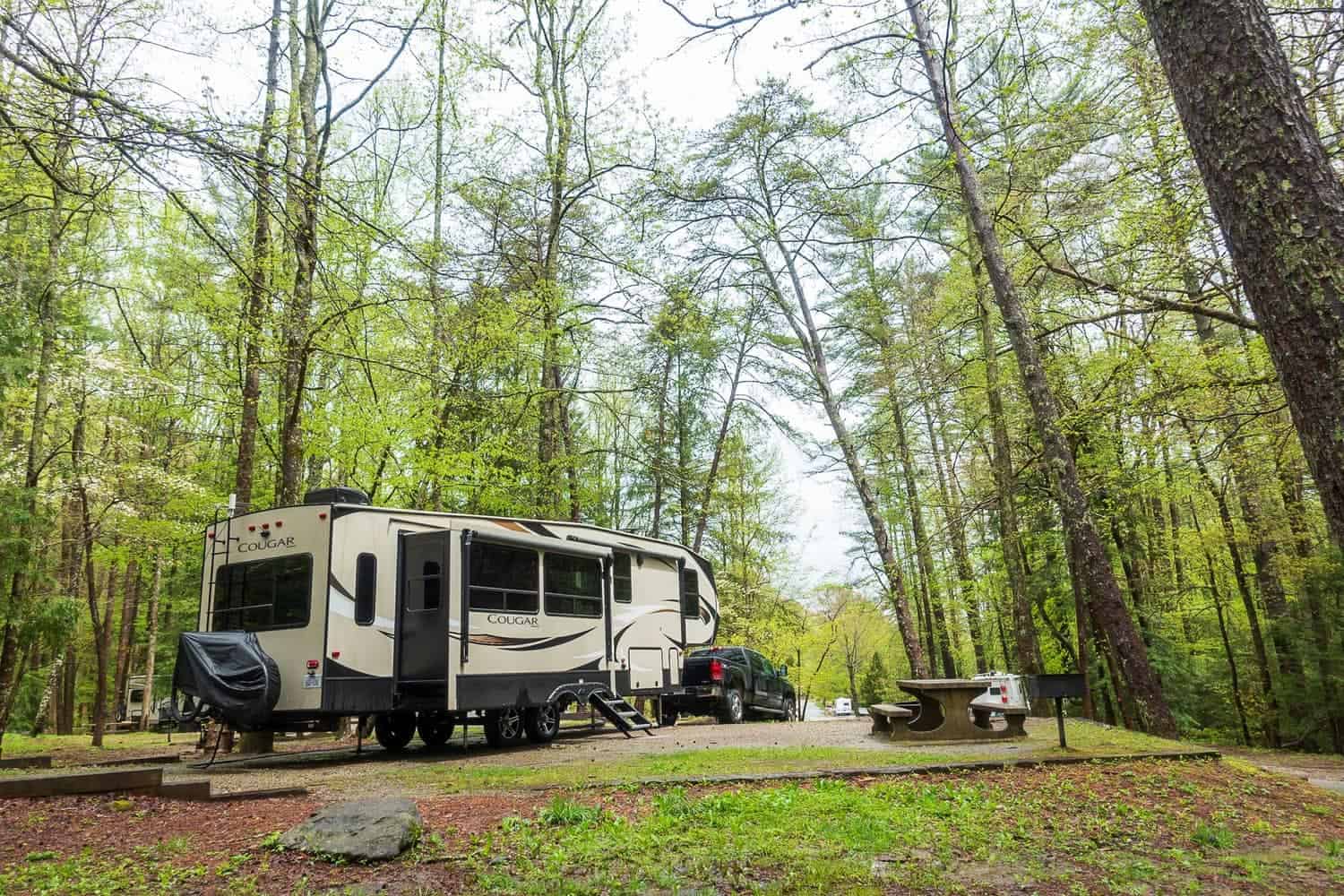
So, you’re planning a camping trip—how exciting! But with so many options out there—from national parks to private resorts to boondocking in the wild—figuring out how to choose a campground can feel overwhelming.
Hi, I’m Cindy. I’ve camped throughout my entire life and spent three years living full-time on the road in an RV, and if there’s one thing I’ve learned, it’s that choosing the right campground isn’t just about location. It’s about knowing what you want: comfort or solitude, convenience or scenery, hookups or going off-grid?
Whether you’re tent camping for a weekend or full-timing in an RV, this guide walks you through the key questions, campground types, and practical tips to help you land the perfect stay.
Let’s dive in and find the perfect place to call home for your next adventure.
Step 1: Ask Yourself These 5 Core Questions First
There are countless options to consider when choosing where to park your camper!
Let’s make it easy by breaking down the five most important campground considerations. This is the fastest way to narrow your campground search!
Answer these honestly:
What Amenities Do You Need?
- Full hookups (electric, water, sewer)?
- Just electric?
- Or are you comfortable with dry camping (having no hookups at all)?
Will the Campground Fit Your RV or Tent Setup?
- Know the length and height of your rig
- Check site size restrictions before booking
- Tent campers: Do you need a platform or a cleared area for your tent?
- Hammock sleepers: Do you need trees for your hammock?
What Activities Are You Planning on Enjoying?
- Are you looking to hike, paddle, sightsee, or relax in nature?
- Choose a spot close to trails, lakes, towns, or in a remote area if that’s more your vibe.
What Do the Reviews Say?
- Look for clues about noise levels, cleanliness, spacing, and Wi-Fi.
- Reviews often reveal whether the vibe is quiet, family-friendly, or more lively.
What’s Your Budget?
- Once you’ve narrowed your list, compare prices.
👉 These questions help you align your needs with the right kind of camping experience, avoiding decision fatigue.
Step 2: Know Your Camping Style + Choose the Right Campground Type
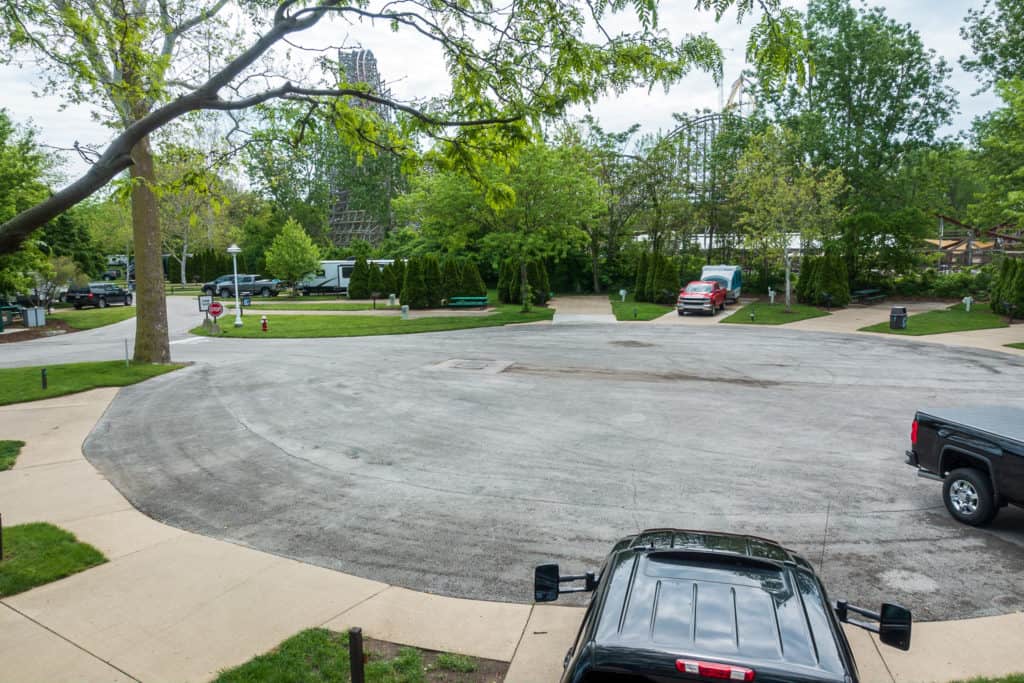
Before diving into locations or reservations, take a moment to think about the kind of camping experience you’re after.
Your style will shape everything, from where you go to what type of campground will work best for you.
Are you looking for:
- Tent camping, RV camping, or staying in a cabin?
- Back-to-nature camping with few distractions?
- RV park comforts like Wi-Fi, showers, and full hookups?
- Rustic public lands with no neighbors in sight?
Choosing the right campground type sets the tone for your trip—whether you’re seeking convenience, a connection to nature, solitude, or affordability.
Once you know your style, use this chart to decide what type of campground fits it best:
Campground Type Comparison Chart
| Campground Type | Who For | Why Choose It | Pros | Cons |
|---|---|---|---|---|
| Private Parks & Campgrounds | For those new to camping or who appreciate structured comfort and reservation ease | Less stress – comfort & convenience | Full, reliable hookups (water, electric, sewer), On-site amenities (Wi-Fi, restrooms, stores, playgrounds, pools), easy booking | Limited hookups and services, less predictable cell/Wi‑Fi; remote conditions, coveted – book far in advance |
| Federal Campgrounds (National Parks & Forests) | For campers seeking animal spotting, a chance to disconnect, and immersive, scenic experiences within protected landscapes | Located inside national parks or forests, epic scenery & wildlife | More expensive, can feel crowded, and less connected to nature | Popular parks will fill quickly and get crowded, with fewer services and dining/shopping nearby |
| State Parks | For those looking for a great balance of natural beauty and moderate amenities | Natural setting + basic amenities | Stunning views, immersive nature, peaceful, and budget-friendly | Often close to towns, shops, and local amenities, with Lower cost |
| County or City Campgrounds | Stunning views, immersive nature, peaceful, and budget-friendly | Urban access or quick overnight stays | Minimal amenities may feel less scenic | No hookups or amenities, must be fully self-contained, requires planning, water, power, and waste management |
| Boondocking | For those craving solitude, adventure, and the lowest cost | Total solitude & freedom | Free or low-cost, remote, peaceful, private | No hookups or amenities, must be fully self-contained, Requires planning, water, power, and waste management |
📝 Tip: During our full-time RV travels, we often stayed in state parks. For us, we found they provided the perfect middle ground between nature and amenities. When we craved quiet and space, we boondocked in national forests for free. When we craved amenities, we booked a spot at a private park.
Next, we’ll match your camping style and campground type with the location and features that will make your trip a success.
Step 3: Choose Your Destination
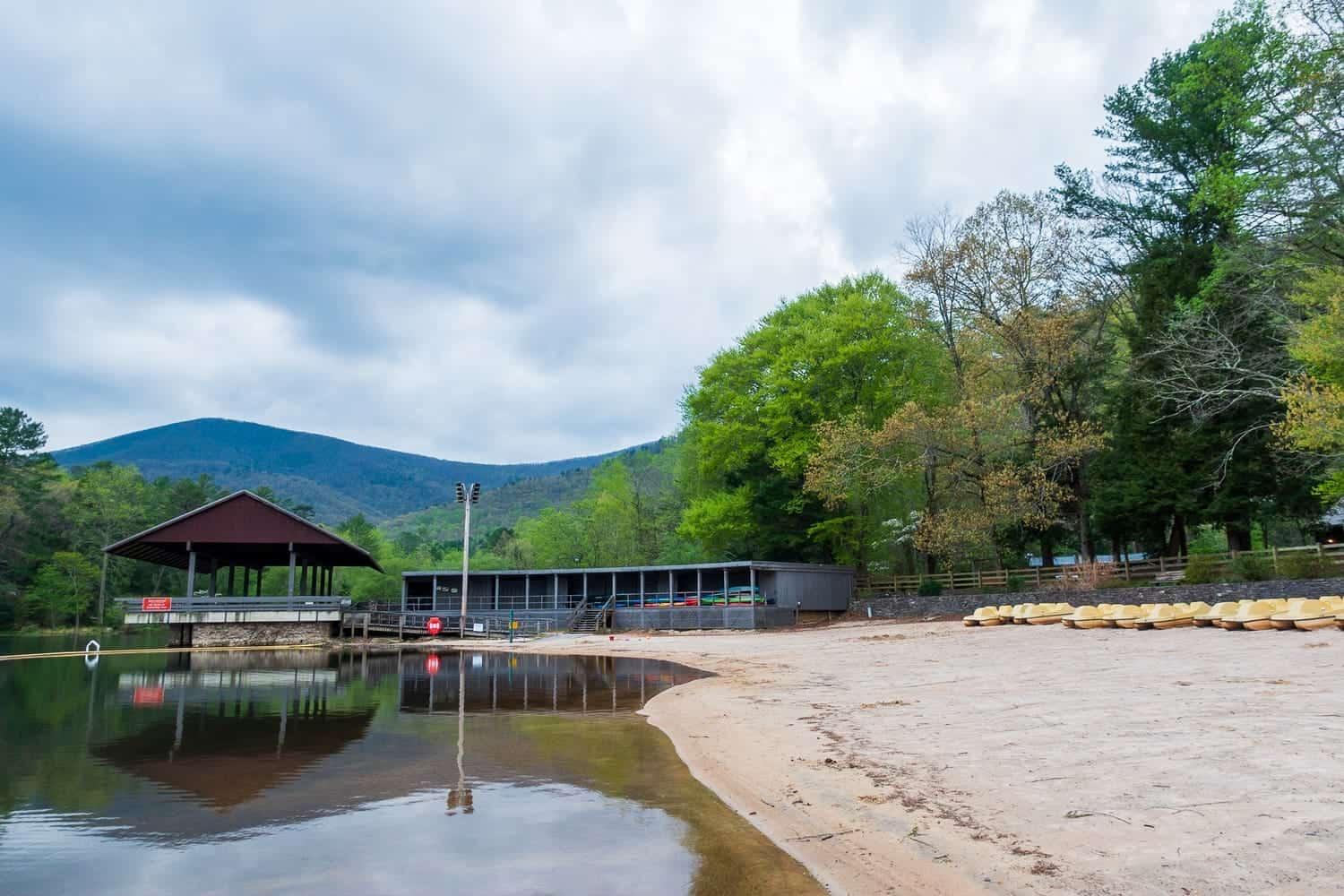
You’ve figured out your style and what type of campground suits you.
Now it’s time to decide where to pitch your tent or park your RV and what kind of experience you want to have while there.
As outlined in Create the Ultimate Camping Plan, the first decision is to decide where you’d like to go camping—whether you imagine towering trees, winding lakeshores, or open wilderness.
Ask yourself:
1. What Kind of Environment Do You Want?
- Lakeside, forest, desert, or mountains?
- Do you want peace and quiet or a social campground atmosphere?
2. How Close Do You Want to Be to the Action?
- Are you exploring nearby towns, wineries, or national park trails?
- Would you rather disconnect and be far from it all?
👣 Example: On a trip to Traverse City, MI, we picked a big state park right in town for easy bike access to shops and trails. It was perfect for urban exploring—but on weekends, it turned into party central!
📝 Tip: If you’re aiming for peace and solitude, steer clear of large in-town parks and look for more remote options.
3. What’s Around the Campground?
- Nearby towns and services: If being close to shops, groceries, or tourist attractions is essential to you, private parks or commercial campgrounds near towns may suit you best.
- Access to the outdoors: Covet access to hiking trails, fishing spots, paddle boarding, or coastal walks? Many of the best lakeside and forest-adjacent campgrounds highlight these features.
📝 Tip: For quick resupplies, consider choosing private or county parks located near towns. For adventure access, state and federal parks are often the best options.
4. When Are You Going?
- Summer = crowds and high demand (book 6+ months out!)
- Spring/Fall = fewer people, but be sure to check the weather and be aware of seasonal closures.
📆 Check seasonal reservation windows—spots will fill up quickly for summer and holiday weekends. Many national and state parks release sites exactly six months ahead, and you better believe campers will be poised to book on the website exactly six months in advance.
- Use flexibility to your advantage: If your dates and campground preferences are more flexible, you can book a spot a bit later.
- If you missed out, consider searching nearby private parks (like KOAs) or looking for last-minute cancellations.
📝 Tip: You can find last-minute camping spots on Hipcamp, The Dyrt, Campspot, AllStays, RV Parky, and Good Sam.
5. Does Your Budget Match the Experience?
- Free = Dispersed camping and boondocking on public lands are excellent for solitude and budget, but offer no amenities. You must be fully self-sufficient.
- Mid-range = State or county parks (basic hookups)
- High-end = Private parks with pools, Wi-Fi, and hot tubs cost more but make life easier.
Once you’ve narrowed it down to a few places, then compare prices, not the other way around.
Next, we’ll cover hookups, amenities, and how to choose a campground based on factors such as comfort, Wi-Fi, bathrooms, and other key considerations.
Step 4: Hookups & Amenities – What Comforts Do You Need?
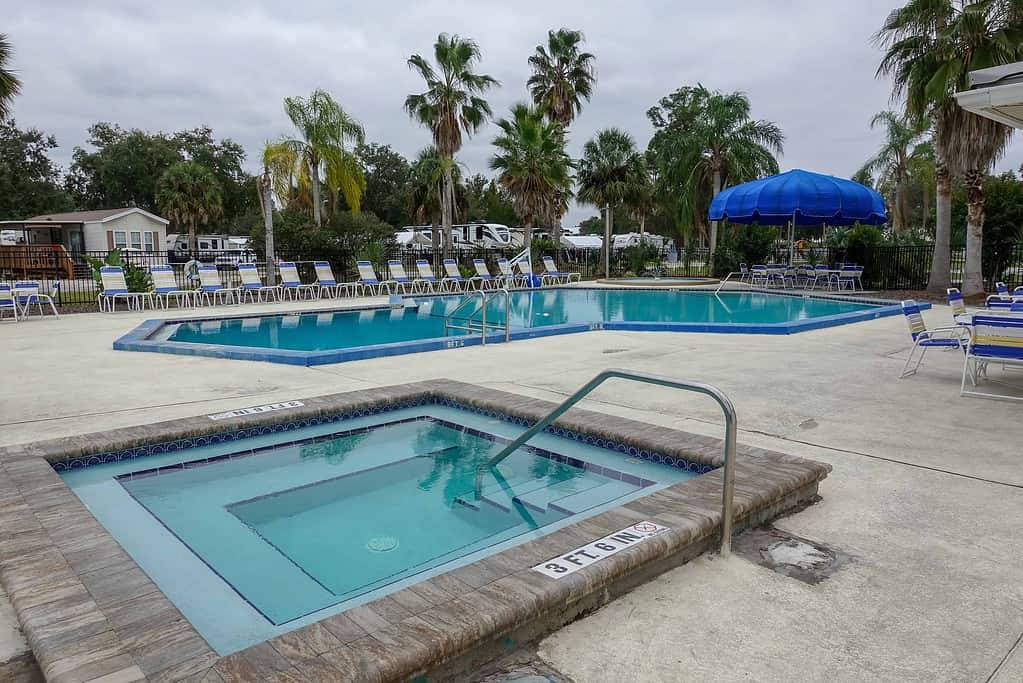
One of the fastest ways to narrow down your campground options is by deciding what hookups and amenities you want—or are willing to live without.
Hookups
Are you someone who wants every modern comfort at your site? Or are you cool with roughing it?
When evaluating possible campgrounds, consider the following hookup options and how they’ll impact your comfort and convenience:
Types of Hookups Comparison Chart
| Hookup Type | Found At | Pros | Cons |
|---|---|---|---|
| Full Hookups | Private RV Parks (KOA, Jellystone). Often close to national or state parks. | Comfort – Electric, water, sewer, and sometimes even cable TV, with extra amenities scattered throughout the park. | Most expensive; may feel crowded and more like outdoor apartment living than being in nature. |
| Partial Hookups | State Parks, Rustic Private Parks | Offering only electric or electric and water, often more affordable and more scenic | Quiet, wild, beautiful, cheap, or free |
| Dry Camping | National Parks and Forests, Boondocking | Quiet, wild, beautiful, cheap or free | No hookups; you’re likely to experience issues with Wi-Fi and cell service. Prep is essential. Make sure to have a generator, water, and propane ahead of time. |
| Overnight Only | Walmarts, Cracker Barrels, Truck Stops, and Casinos | Free, good for one-night stops on travel days, on the way to or from your destination. | Not scenic, may have sketchiness or rules (you should either call ahead or look for signage). |
| Harvest Hosts | Farms, breweries, and wineries | A unique overnight experience offering a better overnight camping option. | Low annual membership required, no hookups |
📝 Tip: If you’re staying at a park with no water, you will have to stock up on water ahead of time. If you’re staying at a park with no sewage, you may need to invest in a rolling tote tank if you want to dump your tanks without moving your entire RV during your stay.
Amenities
Now that you’ve taken a moment to decide what level of hookups you want, also consider amenities.
Depending on your camping style, these extras can make or break your trip:
Wi-Fi & Cell Service
- Private parks usually have the best Wi-Fi. However, expect spotty performance at all of them.
- Public Lands, State Parks, and National Parks often only have Wi‑Fi in specific shared facilities (which can be unreliable), and cell coverage is inconsistent at these spots.
📝 Tip: If working remotely or streaming movies matters to you, check recent reviews or call ahead to confirm Wi-Fi and cell signal strength.
On-Site Services
- Stores, restaurants, playgrounds, pools, and gear rentals are more common at private parks. (For instance, the Mount Rushmore KOA includes all of those things, plus a pizza shop, ice cream store, wine tasting room, and a full camping store.)
- State parks may offer outdoor-focused basics—like firewood or kayak rentals—but not much more.
Bathrooms & Showers
- Bathhouse quality varies widely. Some are brand-new, others… not so much.
📝 Tip: Read reviews for comments on bathroom cleanliness and available facilities, especially if traveling with kids, for extended stays, or if you’re not using an RV bathroom.
Mail & Receiving Packages
- Some campgrounds and private parks allow deliveries. If receiving mail is vital to you, call ahead before arriving.
📝 Tip: As full-timers, we often relied on Escapees and General Delivery for mailing services, planning ahead to ensure we received mail items on time.
Next, we’ll discuss seasonal considerations because when you go camping, it can be just as important as where you go.
Step 5: Consider the Season of Your Trip
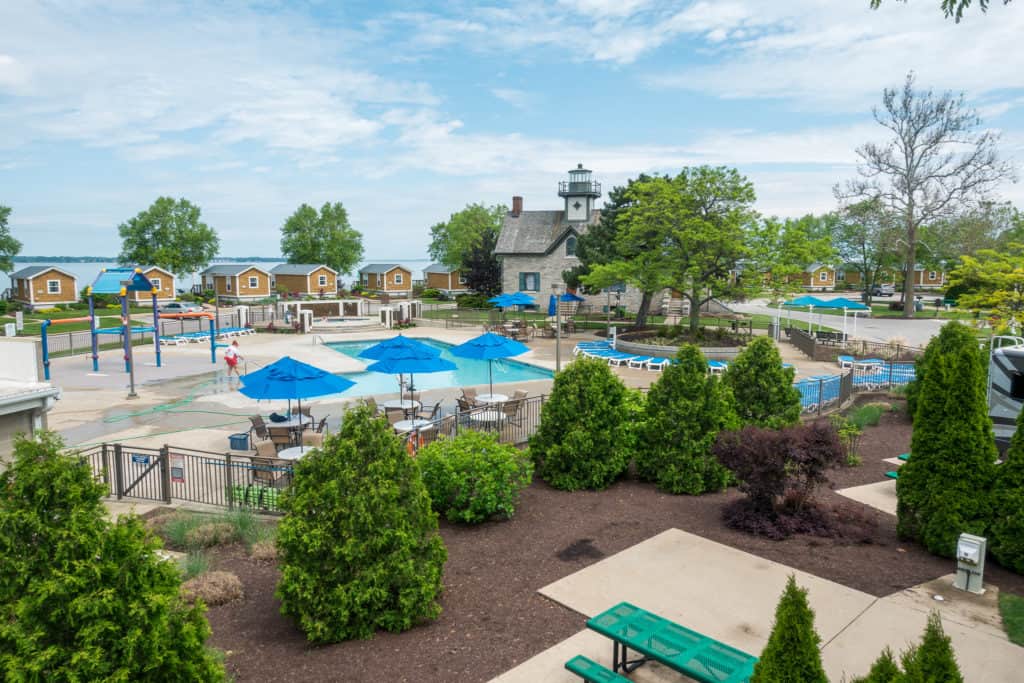
The time of year you decide to go camping matters. It affects everything from weather and crowds to vibe, activities, pricing, and availability.
Here’s what to expect by season, plus gear and booking tips to help you plan accordingly.
🌸 Spring
Why Go? Spring camping brings cooler temperatures, blooming wildflowers, fewer crowds, and the return of outdoor adventure after winter. However, it can also mean unpredictable conditions.
What to Expect: Rain, muddy trails, chilly mornings, and limited early-season amenities.
Gear Tips: Spring hiking calls for waterproof layers, sturdy hiking boots, and rain protection for electronics.
Booking Tip: Many state parks begin opening more services in spring, but not everything is guaranteed to be available early in the season. Always check ahead.
☀️ Summer
Why Go? Summer is the peak season for American families to hit the road and go camping (especially for trips to national or state parks), and for good reason! You’ll enjoy long days, complete campground services, and endless opportunities for adventure.
What to Expect: Crowded campgrounds due to high demand and limited availability, especially in national and state parks.
Gear Tips: Sun protection, fans, bug spray, and shade tarps.
Booking Tip: National and state parks often fill up 6 months in advance—book early or consider flexible private parks nearby.
🍂 Fall
Why Go? Fall is one of the best-kept secrets of the camping world! The crowds begin to thin, but the beauty only improves.
What to Expect: Crisp air, vibrant fall foliage, earlier sunsets, partial closures, and cooler temps—ideal for hiking, biking, and exploring without the summer heat. Or for seeing fall colors on scenic drives!
Gear Tips: Layers, cozy blankets, and headlamps.
Booking Tip: Many campgrounds remain open through October, but services may be scaled back, especially in northern states.
❄️ Winter
Why Go? Winter camping requires more preparation, but it offers peace, solitude, lower rates, and access to unique seasonal destinations.
What to Expect: Many parks close or reduce services, especially in cold-weather states. Be prepared for freezing temps and check availability ahead of time.
Gear Tips: RV skirting, heated hoses, insulation, and an indoor-safe space heater. (You can read more about winter RV living necessities here.)
Booking Tip: Many RVers head south in winter—Arizona, Texas, and Florida are popular destinations—campgrounds in these areas will fill up quickly. Book early!
Next, we’ll dive into how to choose the best individual site at a campground since the right spot can make all the difference!
Step 6: How to Pick the Best Site at a Campground
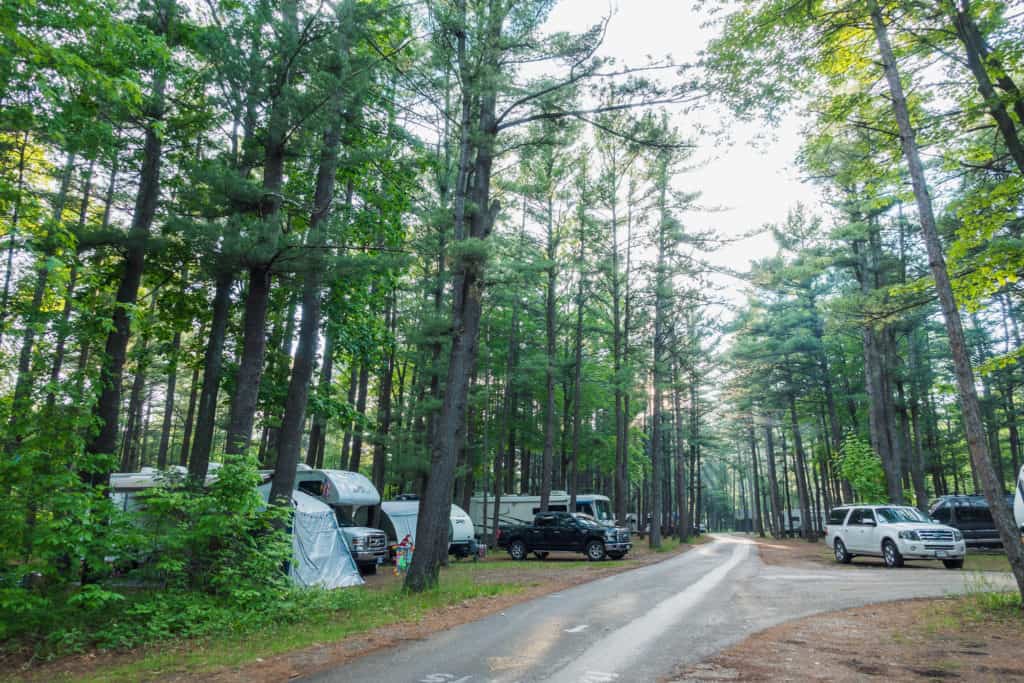
Once you’ve chosen your campground, the exact site you book can seriously shape your experience, especially for more extended stays.
Some sites are peaceful and private. Others… back you right up to the dumpster or the noisy bathhouse.
With a bit of preparation, observation, and flexibility, you’ll find a site that perfectly suits your rig, trip style, and comfort level.
Here’s how to assess site options, both before booking and once you’re there.
Before You Book (How to Research a Campground)
These small details can make a huge difference in your everyday comfort. Before booking a camp spot, take 5 minutes to:
Use the Campground Website
Be aware of their rules ahead of time, especially if you’re traveling with pets, generators, or extra people or vehicles.
- Are pets allowed? Some parks limit pets or charge a fee for them.
- Do they allow campfires? Rules change based on local fire danger.
- Age restrictions? Some RV parks are 55+ only.
Also, be aware of their cancellation policy. A flexible one will offer less stress.
Use the Campground Map
Most campground websites offer maps. Review the site layout to assess the spacing between sites, layout, and site orientation. Photos and reviews often reveal whether the sites are private or packed together.
Note the site’s proximity to water, restrooms, amenities, high-traffic areas, and trails.
Match the Site Size to Your Setup
Confirm that your RV or tent setup will fit (especially in older parks).
If RV camping, know your rig’s length and height.
Some parks—especially older and more rustic ones, state parks, and national parks—can’t accommodate large RVs. Check site specs before booking.
📝 Tip: Most private parks are typically more accommodating for larger RVs and motorhomes.
Check Reviews for These Key Details
- Wi-Fi and cell service: These are essential for remote work and safety. Verify coverage using app reviews on sites such as Campendium or coverage maps to ensure you’ll have a reliable connection.
- Privacy: Is there any? Are sites packed in tightly with neighbors?
- Noise Levels: Look for reviews that mention if specific sites are near highways, amphitheaters, playgrounds, or pools.
- Vibe: Is the place family-friendly, remote, party-ish?
- Bathrooms: Are they functional and clean? Always try to find out the conditions of the bathrooms, especially if you’re traveling with kids.
- Views: What are the views like—trees, water, another RV?
- Shade and sun direction.
📝 Tip: Look for user-uploaded photos and recent comments. Those tell the real story.
I’ve personally found that reviews on sites like TripAdvisor, Campendium, and Good Sam are often spot-on. They help you understand:
Once You Arrive (if You’re Choosing on Site)
If you are choosing your site upon arrival, consider these details while picking a spot for optimal comfort:
Sun Direction
Do you want to wake up with the sun?
East-facing sites = sunny mornings. West-facing sites = sunsets.
Trees & Shade
Shade Pros: Trees provide shade, which keeps you cool and gives you a peaceful canopy overhead.
Shade Cons: If you need sun to juice up solar panels and open space for Starlink efficiency, you may not want tree shade.
Caution: Avoid lone trees on exposed ridges—lightning risk is a genuine concern.
Bonus: Look for logs, stumps, or boulders—built-in seating!
Water Proximity
Consider how far you’ll need to go for water or restrooms. Sites closer to spigots will provide easier access to water, but will be busier.
📝 Tip: We once stayed in a site with a perfect creek view—but it turned out to be right next to a noisy bathroom. Now, I always check the map and call ahead if necessary to ask about quiet sites.
For Dry Camping or Boondocking? You’ll need to plan ahead and fill up your tank before you settle in.
Hazards & Surroundings
Exposed ridges: Great views—but also prone to more wind and storms. If you see steep slopes above you, think flood run-off.
Watch for hazard signage: Animal warnings, bear boxes, or off-limits areas can indicate local hazards.
Breeze & Bug Control
A slight elevation and open airflow help deter mosquitoes. A gentle breeze can make warm evenings more pleasant and buggy evenings much more bearable.
Look for sites with open-air flow, which is especially helpful during mosquito season.
Ground Surface & Drainage
Flat sites = a more straightforward setup and better sleep. For RVers, slight slopes will work, too, if you have leveling blocks.
Try not to book a site in a valley or gully—standing water = soggy trip. Also, those sites may flood in heavy rain.
A site with a gentle grade that drains well is optimal.
Next, I’ll move into trip planning, reservation strategy, and booking tools to help you secure your spot, whether you’re a planner or a spontaneous traveler.
Step 7: Trip Planning & Reservations
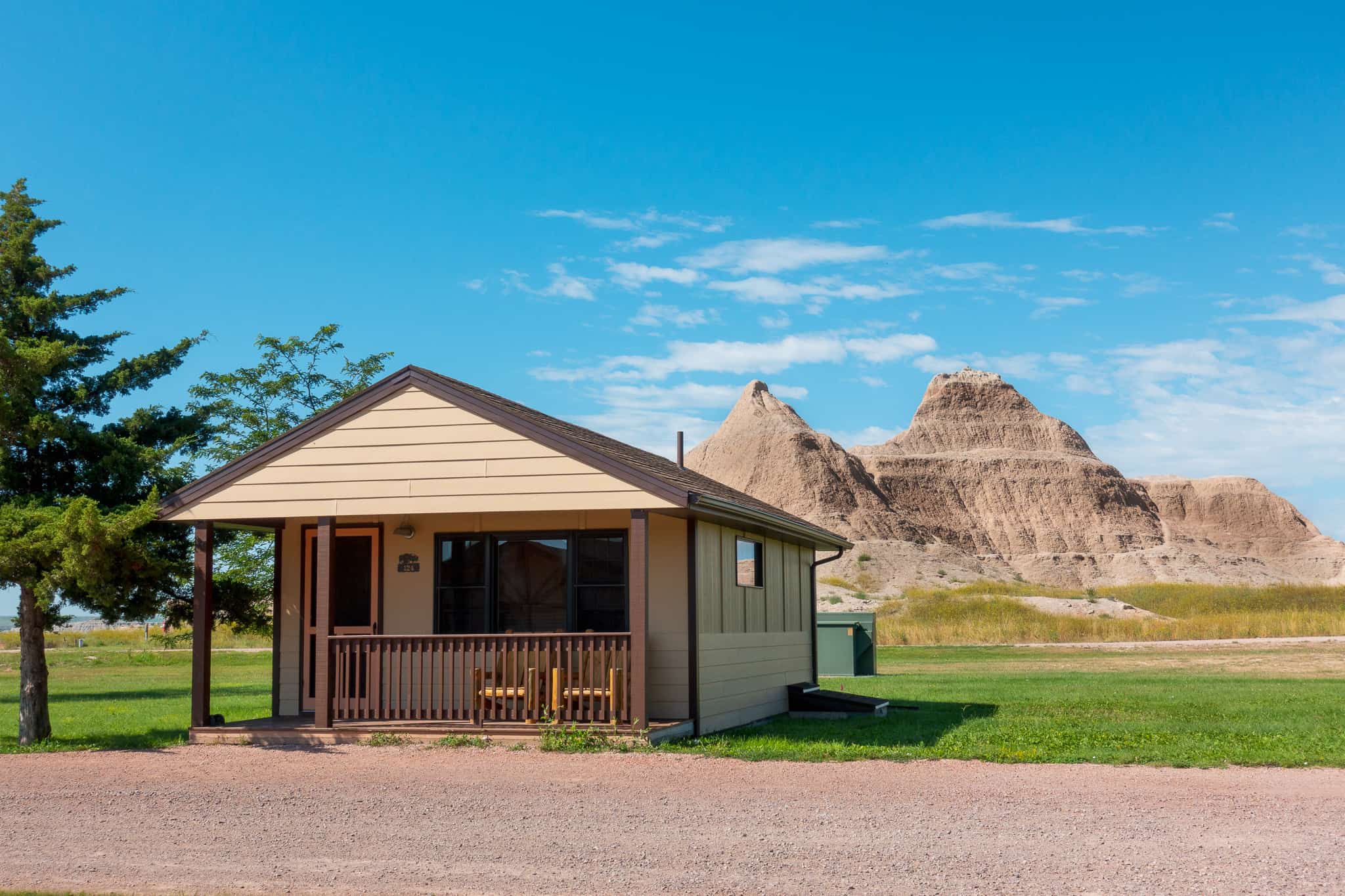
Planning ahead doesn’t have to be stressful, but if you’re traveling during peak seasons, a little strategy goes a long way.
Whether you’re a Type A planner or a go-with-the-flow traveler, here’s how to book with confidence and find a great site.
Know Your Booking Style
| Style | Best For… | Tools & Tips |
|---|---|---|
| Planner | Summer trips, families on a tight schedule, and national parks | Book 4–6 months ahead, especially for holiday weekends |
| Spontaneous | Flexible dates, boondockers, and off-season | Use apps like Campendium or The Dyrt for last-minute spots |
Top Tools for Finding & Booking Campsites
| Tool | Use It For… |
|---|---|
| Campendium | Reviews, cell service, boondocking info |
| The Dyrt | Campground search with photos & reviews |
| Campspot | Campground search with photos & reviews |
| Hipcamp | Unique private land stays |
| RV Trip Wizard | Route planning & campground matching |
| KOA | Reliable parks with clean facilities |
| Good Sam | Reviews |
| Recreation.gov | National park and forest campground bookings |
“Before You Book” Checklist
✅ Does your RV or tent setup fit the site?
✅ Do the amenities match your needs?
✅ What do reviews say about Wi-Fi, bathrooms, privacy, and crowd level?
✅ Are pets, generators, and campfires allowed?
✅ What’s the cancellation policy?
📝 Tip: Don’t let a fully booked campground ruin your trip plans. Call daily to check for cancellations; I’ve scored amazing last-minute sites this way!
However, also always have a backup site reserved somewhere else with a flexible policy, just in case nothing ever opens up. And don’t stress, I’ve had great experiences staying at private parks just outside park borders.
Next up: I’ll wrap this up with budgeting tips, packing suggestions, and final thoughts.
Step 8: Budgeting, Packing & Final Prep
Now that you’ve narrowed down your perfect campground, it’s time to wrap things up with wise choices around budget, gear, and getting ready to roll.
Budget
Unlike hotel bookings, campgrounds don’t vary wildly in price, so let your wants and needs guide you first. Once you’ve narrowed your options, compare prices.
- Free or cheap: Boondocking, dispersed camping, overnight stops (Walmart, Cracker Barrel)
- Mid-range: State and county parks with partial hookups
- Higher-end: Private resorts and KOAs with full amenities
📝 Tip: I always choose based on vibe, location, and amenities, then I consider the price. If I have two great options, I’ll choose the cheaper one. Unless one has a hot tub. Then, I choose the hot tub. 🙂
Packing Tips
You don’t need to bring everything—just the right things. Whether it’s a weekend getaway or a multi-month RV journey, here’s what to think about:
Essentials:
- Sunscreen, bug spray, water bottles, reusable dishes
- Snacks
- Cooking gear, trash bags
- Weather-appropriate layers
Comfort:
- Layers for shifting weather
- Comfy camping chairs, hammock, or blanket
- Headlamps, lanterns, or string lights
- Small broom for keeping dirt out of your tent or rig
Fun:
- Fishing gear or bikes (if the campground allows)
- Books, cards, games, journal, and music for campfire evenings
- Binoculars or a camera for nature spotting
Helpful Tools & Memberships to Save Time and Money
If you’re camping regularly, these clubs can help save money and simplify booking:
Good Sam – Discounts at thousands of campgrounds across North America.check
Escapees – Ideal for full-timers (Great for community and mail services.) (Enter promo code CINDERS20 at checkout for 20% OFF!)
Harvest Hosts – Unique overnight stays at farms & breweries. (Enter promo code CINDERS20 at checkout for 20% OFF!)
Thousand Trails – Popular for long-term travelers and full-timers.
KOA Rewards – Great for consistency, clean facilities, and a solid cancellation policy.
Passport America – Discounts at campgrounds across North America.
Final Thoughts on How to Choose a Campground: Plan Smart, Stay Flexible, and Enjoy the Journey!
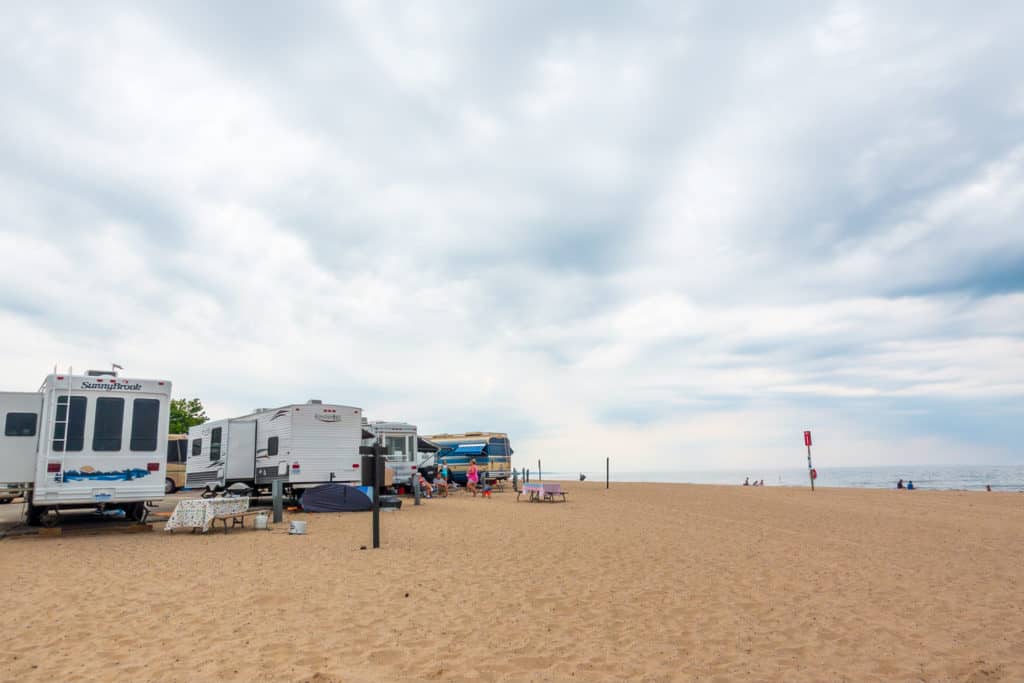
Whether you’re trying to figure out how to choose a campground for the first time or you’re a seasoned traveler, the biggest takeaway is this: the best trips blend planning with spontaneity.
- Book early when you need to, especially for peak seasons and national parks.
- Don’t stress if your first pick is full. There are always great alternatives nearby.
- Stay flexible and curious—some of our favorite campsites were places we found when our first choice was already full.
📝 Final Tip: Once, we couldn’t get into a popular national park. We stayed at a private park right outside the park’s borders, and it ended up being one of our all-time favorites! Fewer crowds, amazing trails, and an epic sunset view we didn’t even plan for!
You May Also Enjoy:
👉 Create the Ultimate Camping Plan: Step-by-Step for RV, Tent, or Trail
👉 We Slept at Breweries & Farms: Our Honest Harvest Hosts Review
👉 11 Best Lakeside Campgrounds According to 2 Full-Time RVers
- Appalachian Trail Hike Week 8: Roan Highlands, Rain, & Renewed Motivation - October 22, 2025
- Ultimate Guide: 60+ National Parks Gifts for Park Lovers of Every Age - October 11, 2025
- What It’s Like to Hike the Appalachian Trail: Week 7 on the AT - September 25, 2025

